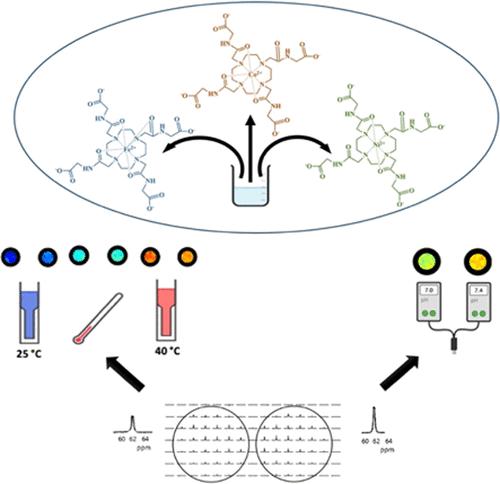当前位置:
X-MOL 学术
›
Inorg. Chem.
›
论文详情
Our official English website, www.x-mol.net, welcomes your
feedback! (Note: you will need to create a separate account there.)
Complexes of Iron(II), Cobalt(II), and Nickel(II) with DOTA-Tetraglycinate for pH and Temperature Imaging Using Hyperfine Shifts of an Amide Moiety
Inorganic Chemistry ( IF 4.3 ) Pub Date : 2024-11-13 , DOI: 10.1021/acs.inorgchem.4c04023 Sandeep Kumar Mishra, ABM Zakaria, Jelena Mihailovic, Samuel Maritim, Brandon Mercado, Daniel Coman, Fahmeed Hyder
Inorganic Chemistry ( IF 4.3 ) Pub Date : 2024-11-13 , DOI: 10.1021/acs.inorgchem.4c04023 Sandeep Kumar Mishra, ABM Zakaria, Jelena Mihailovic, Samuel Maritim, Brandon Mercado, Daniel Coman, Fahmeed Hyder

|
Paramagnetic complexes of 1,4,7,10-tetraazacyclododecane-1,4,7,10-tetraacetate (DOTA4–) derivatives have shown potential for molecular imaging with magnetic resonance. DOTA-tetraglycinate (DOTA-4AmC4–) coordinated with lanthanide metal ions (Ln3+) demonstrates pH/temperature sensing with Biosensor Imaging of Redundant Deviation in Shifts (BIRDS) and Chemical Exchange Saturation Transfer (CEST), respectively, detecting nonexchangeable (e.g., −CHy, where 3 ≥ y ≥ 1) and exchangeable (e.g., −OH or –NHx, where 2 ≥ x ≥ 1) protons. Herein, we report paramagnetic complexes of divalent transition-metal ions (M2+ = Fe2+, Co2+, Ni2+) with DOTA-4AmC4– that endow a unique amide proton (−NH) moiety for pH/temperature sensing. Crystallographic data reveal that DOTA-4AmC4– coordinates with M2+ through oxygen and nitrogen donor atoms, ranging in coordination numbers from 8-coordinate in Fe(II)DOTA-4AmC2–, 7-coordinate in Co(II)DOTA-4AmC2–, and 6-coordinate in Ni(II)DOTA-4AmC2–. The −CHy protons in M(II)DOTA-4AmC2– displayed modest pH/temperature sensitivities, but –NH protons exhibited higher intensity, suggesting prominent BIRDS properties. The pH sensitivity was the highest for Ni(II)DOTA-4AmC2– (1.42 ppm/pH), followed by Co(II)DOTA-4AmC2– (0.21 ppm/pH) and Fe(II)DOTA-4AmC2– (0.16 ppm/pH), whereas temperature sensitivities were comparable (i.e., 0.22, 0.13, and 0.17 ppm/°C, respectively). The CEST image contrast for –NH in M(II)DOTA-4AmC2– was much weaker compared to that of Ln(III)DOTA-4AmC–. Given its high pH sensitivity and low cytotoxicity, Ni(II)DOTA-4AmC2– shows promise for use in preclinical BIRDS-based pH imaging.
中文翻译:

铁 (II)、钴 (II) 和镍 (II) 与 DOTA-四甘氨酸酯的络合物,用于使用酰胺基团的超精细位移进行 pH 和温度成像
1,4,7,10-四氮杂环十二烷-1,4,7,10-四乙酸酯 (DOTA4–) 衍生物的顺磁性复合物已显示出磁共振分子成像的潜力。与镧系金属离子 (Ln3+) 配位的 DOTA-四甘氨酸酯 (DOTA-4AmC4–) 分别通过位移冗余偏差生物传感器成像 (BIRDS) 和化学交换饱和转移 (CEST) 进行 pH/温度传感,检测不可交换(例如,−CHy,其中 3 ≥ y ≥ 1)和可交换(例如,−OH 或 –NHx,其中 2 ≥ x≥ 1) 质子。在本文中,我们报道了二价过渡金属离子(M2+ = Fe2+、Co2+、Ni2+)与 DOTA-4AmC4– 的顺磁性络合物,它们赋予了用于 pH/温度传感的独特酰胺质子 (-NH) 部分。晶体学数据显示,DOTA-4AmC4– 通过氧和氮供体原子与 M2+ 配位,配位数范围从 Fe(II)DOTA-4AmC2– 中的 8 位、Co(II)DOTA-4AmC2– 中的 7 位和 Ni(II)DOTA-4AmC2– 中的 6 位。M(II)DOTA-4AmC2– 中的 -CHy 质子表现出适度的 pH/温度敏感性,但 -NH 质子表现出更高的强度,表明突出的 BIRDS 特性。Ni(II)DOTA-4AmC2– (1.42 ppm/pH) 的 pH 敏感性最高,其次是 Co(II)DOTA-4AmC2– (0.21 ppm/pH) 和 Fe(II)DOTA-4AmC2– (0.16 ppm/pH),而温度敏感性相当(分别为 0.22、0.13 和 0.17 ppm/°C)。与 Ln(III)DOTA-4AmC– 相比,M(II)DOTA-4AmC2– 中 –NH 的 CEST 图像对比度要弱得多。 鉴于其高 pH 敏感性和低细胞毒性,Ni(II)DOTA-4AmC2– 有望用于基于 BIRDS 的临床前 pH 成像。
更新日期:2024-11-13
中文翻译:

铁 (II)、钴 (II) 和镍 (II) 与 DOTA-四甘氨酸酯的络合物,用于使用酰胺基团的超精细位移进行 pH 和温度成像
1,4,7,10-四氮杂环十二烷-1,4,7,10-四乙酸酯 (DOTA4–) 衍生物的顺磁性复合物已显示出磁共振分子成像的潜力。与镧系金属离子 (Ln3+) 配位的 DOTA-四甘氨酸酯 (DOTA-4AmC4–) 分别通过位移冗余偏差生物传感器成像 (BIRDS) 和化学交换饱和转移 (CEST) 进行 pH/温度传感,检测不可交换(例如,−CHy,其中 3 ≥ y ≥ 1)和可交换(例如,−OH 或 –NHx,其中 2 ≥ x≥ 1) 质子。在本文中,我们报道了二价过渡金属离子(M2+ = Fe2+、Co2+、Ni2+)与 DOTA-4AmC4– 的顺磁性络合物,它们赋予了用于 pH/温度传感的独特酰胺质子 (-NH) 部分。晶体学数据显示,DOTA-4AmC4– 通过氧和氮供体原子与 M2+ 配位,配位数范围从 Fe(II)DOTA-4AmC2– 中的 8 位、Co(II)DOTA-4AmC2– 中的 7 位和 Ni(II)DOTA-4AmC2– 中的 6 位。M(II)DOTA-4AmC2– 中的 -CHy 质子表现出适度的 pH/温度敏感性,但 -NH 质子表现出更高的强度,表明突出的 BIRDS 特性。Ni(II)DOTA-4AmC2– (1.42 ppm/pH) 的 pH 敏感性最高,其次是 Co(II)DOTA-4AmC2– (0.21 ppm/pH) 和 Fe(II)DOTA-4AmC2– (0.16 ppm/pH),而温度敏感性相当(分别为 0.22、0.13 和 0.17 ppm/°C)。与 Ln(III)DOTA-4AmC– 相比,M(II)DOTA-4AmC2– 中 –NH 的 CEST 图像对比度要弱得多。 鉴于其高 pH 敏感性和低细胞毒性,Ni(II)DOTA-4AmC2– 有望用于基于 BIRDS 的临床前 pH 成像。


















































 京公网安备 11010802027423号
京公网安备 11010802027423号